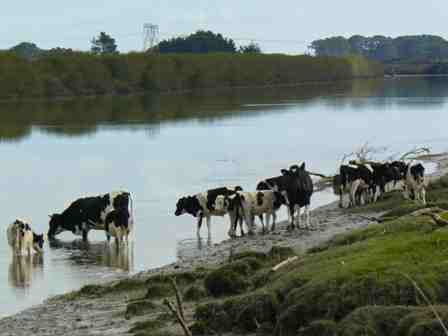
Image from http://envirohistorynz.com/
In yesterday’s article we pointed out how farmers have been converting land to dairy, generating massive private profits tax-free, but leaving the damage to our rivers, lakes and groundwater to be picked up by the public.
The Government has been asleep at the wheel on this – only proper resource pricing and an income-neutral tax regime can save our rivers.
Some responsible dairy farmers do fully incur all or most of the direct environmental costs of their activity. The recent NZ River Awards highlighted that, identifying the three most improved rivers in New Zealand as all benefiting from changed farm practices. The actions of these farmers deserve to be celebrated.
Even the rump of the dairy industry is taking positive strides. Rivers are increasingly being fenced off to stop cows entering, peeing and pooing in them.
The Water Accord sets out standards for sustainable practice around conversions, use of water, planting riverbanks, managing effluent and nutrients. Government are offering the carrot of helping farmers make the changes, while Fonterra is wielding the stick, threatening to make these guidelines part of its supply agreement. The accord will even be independently monitored and audited.
Of course the real test of these measures will come when some farmers refuse to pull up their socks and Fonterra is faced with not taking their milk. Their past track record shows that their tough talk often softens when farmers dig their gumboots in. Nevertheless, a huge amount of work is going in to make dairy farming a sustainable practice, catchment by catchment.
But the experiences around Lakes Taupo and Rotorua tell us that ultimately we will have to limit stock numbers in some areas if we want to save and restore our rivers. The recent spate of conversions will only make the inevitable adjustment all the more painful.
Depending on what state locals want their rivers in, some areas have already overshot the number of cattle that their catchment can bear. Some regions will face a stark trade-off between saving their rivers and giving some of their local farmers a massive financial kick in the guts.
Some farmers will of course blame the demands for better water quality for sending them under, but that is misguided. In some areas conversions must cease, and should have ceased years ago. Now, thanks to years of inadequate environmental pricing and a lax tax regime, farmland prices have been allowed to ratchet so high that farmers have no choice but to farm intensively just to stay afloat. Something will give.
The question is who pays for this adjustment? The taxpayer shouldn’t, as they didn’t create it. Some farmers will be hit harder than others, as this problem is dependent on local conditions such as soil and weather. Inevitably some farmers will be forced out of business, others barely impacted.
This impact could be smoothed by farmers paying a per head “tax” on each cow, heifer and calf. The funds could be ploughed back into developing ways of reducing nitrogen levels in rivers. The aim of the tax would be to minimise the environmental impact per litre of milk produced.
The problems are materialising as greater pressure on farmers to confine cows. While it is easier to deal with the effluent from confined cows, there are many other problems – higher costs of housing, lower milk quality, as well as lower animal welfare. There are also adverse environmental impacts from cropping and harvesting the food for the cows.
If instead farms faced an individual nutrient budget, making it more difficult to permanently import a lot of feed, the way forward would be to stay with pastoral farming, albeit less intensive and focusing instead on the quality of milk and extracting a price premium for that.
All commercial users of water should face a charge. This would acknowledge public ownership of the rivers and create funds to invest in repairing them. Power companies would also pay for public water used in their hydro dams. Certainly the Government should not be subsidising irrigation schemes as they currently are.
Finally, this whole problem highlights the need to get rid of the tax loopholes that owners of capital enjoy. Unlike normal income, the huge profits made from dairy conversions in recent decades were not shared with the taxman. This is yet another effective subsidy other New Zealanders have provided this industry.
The transition we have set out here would be painful. The more conversions that happen the more painful it will become, which is why Dairy NZ have called for conversions to cease.
Sustainable dairy is possible, but not if we want to keep squeezing more cows on the land. But until the industry’s structure makes profit growth synonymous with expansion of downstream manufacture and consumer brands, or application of our on-farm technology advantages in countries where the price of land is much less, we can expect an insatiable demand from farmers here to pollute more in their quest for higher volume.
What the Commissioner for the Environment’s report says is that the mitigation efforts farmers are making will not stop the rot, more and more cows is an environmental disaster. What we would say is the market structures around dairying are what’s driving that quest for more cows – a level playing field would sort that and while on-farm investment would become less attractive, downstream investment would take up any slack.

